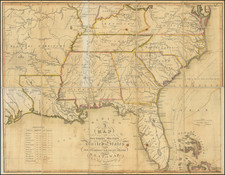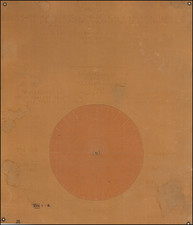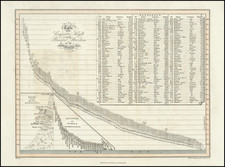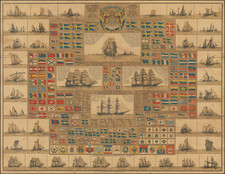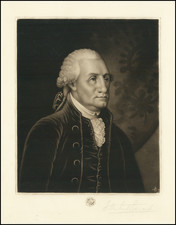An American Indian Rarity
Rare lithographic study or “crayon drawing” of three American Indians, taken from William Henry Powell's Discovery of the Mississippi by De Soto A.D. 1541, the painting commissioned by Congress to be displayed in the Capitol Rotunda in Washington, D.C.
Powell's painting depicts Hernando de Soto's discovery of the Mississippi River, below Natchez, on May 8, 1541. De Soto was the first European to report having seen the Mississippi. Powell's painting shows De Soto and his party approaching the Mississippi, with a Native American encampment in the background. De Soto, on a white horse, approaches the Indians, as one of the chiefs extends a peace pipe to de Soto.
After being commissioned by Congress, Powell worked on the painting in Paris from 1848 to 1853. When completed, it went on display in Paris where it received great acclaim, and where the lithographer, Bernard Romain Julien discovered it.
From the Paris Correspondence of the N. T. Tribune, August 15th, 1853.
There is at this moment in Paris, a painting executed by a young American artist, which is a peculiar source of pride to all Americans who have seen it. It is a source of pride because it has created an enthusiasm among the French critics unusually rare. I speak of the work of Mr. Powell, executed for the vacant panel in the rotunda at "Washington, just finished. It is a work which has run the gauntlet of French criticism, and has come off not only victorious, but with a degree of commendation rarely bestowed upon a single picture. They call it, without hesitation, the best work which has been executed for many years by any foreign artist in Paris—their amour propre would not permit them to pronounce it the best painting; but others do pronounce it the best which has issued from any man's hands in Paris for some time. One of the best tests of the value of this work is the crowds of persons of distinction in the fine arts, as well as in the fashionable world, who daily visit the atelier of Mr. Powell ; for it is known that in a city like Paris, with such vast, and in one sense of the word tiresome museums of paintings, it must be indeed a rare picture that can, by itself, in an out of the way place, attract a crowd of people to see it.
Many of the English and French nobility, and nearly all the distinguished men of art in Paris, have visited the picture of the American artist, and they have all expressed themselves with astonishment and admiration at its perfection. They say that it combines all the elements in perfection of a genuine historical painting—a result rarely attained. So great has been the enthusiasm, that Jullien, the distinguished lithographer, immediately upon seeing it, offered Mr. Powell 500 francs for the privilege of lithographing four studies from it, to be sold to other artists; and that is the same price which he gave to Horace Vernet for the privilege of copying from his great picture of "La Smala," at Versailles, and a higher price than he pays to anyone else. He has also lithographed the head of the artist; while Etex, one of the sculptors of the bas-relief on the Triumphal Arch, and a sculptor of great celebrity, has asked the privilege of taking the artist's head in marble. Several of the journals have given very favourable notices of Mr. Powell and his work, and more will soon appear.
This article mentions that Julien produced four different lithographs of various sections of the painting. Only one, this example (No. 4) has been discovered.
The present work, published in 1854 by the noted art dealer and print publisher William Schaus in New York City and by Francois Delarue in Paris. This image focuses on the 3 Indian chiefs to the right of De Soto which are identified by the official “key” as the “Indian chiefs bearing the pipe of peace.”
Bernard Romain Julien was a French printmaker, lithographer, painter and draughtsman. He was trained to draw in his home town between 1815 and 1818 before moving to Paris, where he studied painting from 1822 onwards under Antoine-Jean Gros at the École des Beaux-Arts.
He exhibited some paintings and drawings at the Paris Salon between 1833 and 1850, but principally showed lithographs, for which he was known. He produced lithographs of other artists, like George Henry Hall's Cours de Dessin. In 1840, he published Étude à deux crayons.
In Landor's Cottage, Edgar Allan Poe describes Julien's work, "One of these drawings was a scene of Oriental luxury, or rather voluptuousness; another was a carnival piece, spirited beyond compare; the third was a Greek female head—a face so divinely beautiful, and yet of an expression so provokingly indeterminate, never before arrested my attention."
Rarity
We locate a single copy at auction (Paris, 2015) in the past 30 years (likely this example).
The only recorded example of the print, other than the Paris auction, seems to have been a copy given by Julien to Powell, as recorded in The National Academy of Design Exhibition Record 1826-1860 as follows:
262. Lithographic Study by Julien from Mr. Powell's De Soto. Exhibited by the print maker and owned by W. H. Powell. 1855 Address: 45 East 22nd Street
Bernard Romain Julien was a French printmaker, lithographer, painter and draughtsman. He was trained to draw in his home town between 1815 and 1818 before moving to Paris, where he studied painting from 1822 onwards under Antoine-Jean Gros at the École des Beaux-Arts.
He exhibited some paintings and drawings at the Paris Salon between 1833 and 1850, but principally showed lithographs, for which he was known. He produced lithographs of other artists, like George Henry Hall's Cours de Dessin. In 1840, he published Étude à deux crayons.
In Landor's Cottage, Edgar Allan Poe describes Julien's work, "One of these drawings was a scene of Oriental luxury, or rather voluptuousness; another was a carnival piece, spirited beyond compare; the third was a Greek female head—a face so divinely beautiful, and yet of an expression so provokingly indeterminate, never before arrested my attention."
In 1854, he made a full-bust portrait of George Washington, after Gilbert Stuart, and the lithograph is in the art collection of Mount Vernon.









